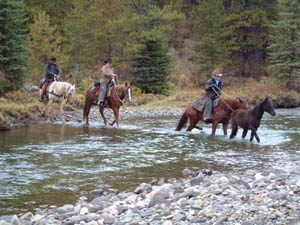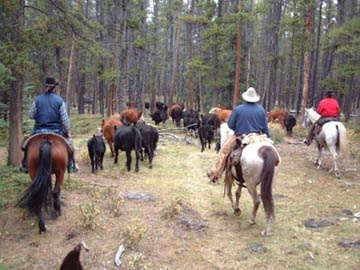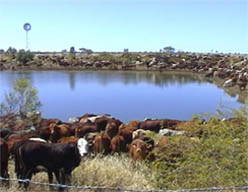|
Explication of "Kiansis I"
The corridista
begins to sing his story, and his listeners immediately identify Kiansis
I as a corrido by the presence of certain fundamental traits of
any corrido. Organized in quatrains to highlight the various verbal
icons, Kiansis I plays on the octosyllable lines and the assonance
in the second and fourth lines of every stanza to give it a “corrido”
structure. Though it lacks the frequently used llamada inicial
del As the corridista
goes on with his tale, Kiansis I becomes more and more captivating.
It sucks in the audience with exclamations like, “¡ah,
que camino tan largo! no contaba con mi vida” and “¡y,
ah, que fuerte aguacerazo! no contaba en volver.” These enthusiastic
cries serve multiple functions. Not only do they help tell the story
and convey the bravery of the vaqueros on the trip, but the heightened
emotion in the corridista’s voice radiates to his listeners,
making their hearts beat just a bit faster, luring them back to Kiansis
I time and time again. To increase emotion,
the corridista portrays the caporal “como queriendo
llorar.” The caporal, the hero of this tale, sounds
a little choked up as he orders his vaqueros not to let the
steers escape. Are these the womanly tears of a villain as in many
corridos, though? No. As Américo Paredes points out, “The
tears apparent in the caporal’s voice are not those of cowardice,
sentiment, or weakness but of frustration, the frustration of a man
used to having his way. He is, needless to say, the leader of the
‘adventurers’ who are leading the herd to Kansas” (Pistol,
228-229). The analyst of corridos may find this phrase, “como
queriendo llorar,” quite useful in demonstrating the traditionalization
of corridos. Originally from Eustaquio Arias, a pre-corrido
of the 1830s, this phrase was like by the community enough that it
popped up again in Kiansis I and then again many other corridos
such as El Asalto a la Hacienda de San Juan, Mariano Reséndez,
Ignacio Treviño, Gregorio Cortez, and Quirina Navarro
(Pistol, 228-232) . As corridos are created, new ideas are
born and old ones die, but phrases that express something important
or heartfelt like this phrase live on.
Picture taken from http://www.tpheart.com/TeepeeHeart110CD.html This verse dyad, “Nos decía el caporal,/ como queriendo llorar" serves as “una formula que precede a los argumentios del personaje.” According to John Holmes McDowell, formulaic systems like this one “facilitate composition in a demanding form, by supplying the given essential idea in a manner which permits maximum flexibility for the creation of a sound correspondence demanded by the corrido’s stanzaic structure” (McDowell 59). McDowell’s assertion provides a reason why this grouping of words has risen up in the recently mentioned corridos. Once this foundation has been laid, the corridista may progress to the habla directa. In the first speech event of Kiansis I, the caporal exhibits his authority by commanding his men not to let the steers past him. In the second, he responds to his men’s request for cigarettes and food by basically saying, “Tough.” In doing so, the caporal displays the fortitude of Mexicans and makes reference to God, something not at all uncommon in corridos.
http://www.australiancattledrive.com The corridista
takes the opportunity to show off the caporal’s steer-lassoing
skills in the fourth stanza. In this corrido, the caporal’s abilities
represent the abilities of Mexican and Texas-Mexican cowboys in general,
so when the corridista praises the deeds of the caporal or his vaqueros,
he is actually praising Mexicans. Another popular corrido concept
is that of the “caballo melado” heard in the fourth
line of this stanza. This honey-colored horse motif reappears twenty
years later in Heraclio Bernal of the 1880s and afterward in
many other corridos. The aspect of
danger emerges in the fifth stanza as the audience learns of the death
of one of the vaqueros. Anxiety of this perilous cattle drive increases
in the sixth as an American comments that “Esos hombres ya
se ahogaron.” The corrido analyst must notice that it is
an American that exposes his fear of the Río Salado, not a
Mexican. Kiansis I expresses the intercultural conflict between
los americanos and los mexicanos through the jactancia,
or boasting, of the Mexican cowboys and the cowardice of the Americans.
As the audience, primarily Hispanic, comes to hear in the next paragraph,
not only are Mexican cowboys skilled steer herders, they far surpass
their American counterparts in their river-crossing abilities as well. As the corrido
comes to a close with the vaqueros’successful arrival
and return to San Antonio in the final two stanzas, the corridistas
employs two
|


